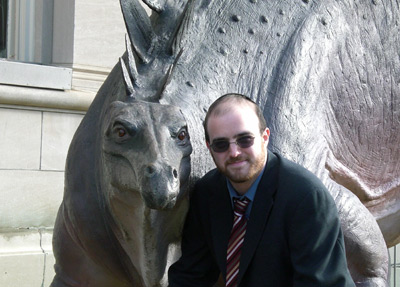Dedication... Take 4
Gut vokh, shavua‘ tov, and hhappy Hhanuka!
This morning at shul, one of the guys who sits near me showed me his hhumash, where it refered to the holiday of guerrilla warfare and religionationalistic rebellion which we are now ( iiiiIiiii ) celebrating not as Hhanuka (or Chanuka, Hanukka, Khanike, Janucá, etc.) — but as "the Fourth חנוכה".
He asked me what was up with that, since the hhumash (this was by the introduction to the haftara for the First Shabbos of Hhanuka) didn't explain it.
Here is what it probably was referring to:
חנוכה means Dedication or Inauguration.
The First חנוכה was חנוכת המשכן, the Dedication of the Mishkan, as described in Bemidbar/Numbers 7.
The Second חנוכה was חנוכת הבית, the Dedication of the First Beit Hamiqdash by King Shelomo, as described in Melakhim/Kings 1:8.
The Third חנוכה was חנוכת הבית, the Dedication of the Second Beit Hamiqdash, as described in ‘Ezra-Nehhemya/Ezra-Nehemiah 1:3.
So therefore the Fourth חנוכה was the Rededication of the Second Temple by the Hasmoneans after kicking the Seleucids and their lackeys out of Jerusalem.
This morning at shul, one of the guys who sits near me showed me his hhumash, where it refered to the holiday of guerrilla warfare and religionationalistic rebellion which we are now ( iiiiIiiii ) celebrating not as Hhanuka (or Chanuka, Hanukka, Khanike, Janucá, etc.) — but as "the Fourth חנוכה".
He asked me what was up with that, since the hhumash (this was by the introduction to the haftara for the First Shabbos of Hhanuka) didn't explain it.
Here is what it probably was referring to:
חנוכה means Dedication or Inauguration.
The First חנוכה was חנוכת המשכן, the Dedication of the Mishkan, as described in Bemidbar/Numbers 7.
The Second חנוכה was חנוכת הבית, the Dedication of the First Beit Hamiqdash by King Shelomo, as described in Melakhim/Kings 1:8.
The Third חנוכה was חנוכת הבית, the Dedication of the Second Beit Hamiqdash, as described in ‘Ezra-Nehhemya/Ezra-Nehemiah 1:3.
So therefore the Fourth חנוכה was the Rededication of the Second Temple by the Hasmoneans after kicking the Seleucids and their lackeys out of Jerusalem.



7 Comments:
Gut IIiiiiii_I!
That's Ezra I 3:3. Or did you mean Ezra, "book" I, "chapter" 3?
Lipman:
when you arrange it that way it looks like a screech :-P
aiiiiiiii-EEEEEE!!!!
Mar Gavriel:
Ezra-Nehhemya, section 1, chapter 3.
Er, right-o. That's probably because I can't use those cheerful colours in comment'ries, isn't it?
So, gut III....._I meanwhile! And that's both facing the menoure and the ocean.
I think the Chanukas haBayis commemorates in the holiday is the third, finally completing the process that started with curtains demarking bayis sheini.
Otherwise, we would be calling it bayis shelishi and be awaiting the 4th one...
R' Micha:
Take it up with the people who published that hhumash (i think it may have been one of the older R' Hirsch ones).
:-)
Hey, if you add in Hurdos's renovations, we could be waiting for Beit Hamiqdash #5 now!
Actually RSRH says it's #8. Sinai, Gilgal, Shilo, Nov, Gideon, bayis 1, bayis 2. He relates this to the 7 days of milu'im, and the 8th day, on which it was built by Moshe.
Why? Moshe didn't need to teach them what to do after 7 days of practice. At the beginning would have made sense.
Rav Hirsch invokes the idea that everything Moshe did was permanent. He wasn't so much putting up the mishkan as foreshadowing the permanence of bayis 3.
See my devar Torah for Pequdei '56 for lessons I take from this.
-mi
Post a Comment
<< Home